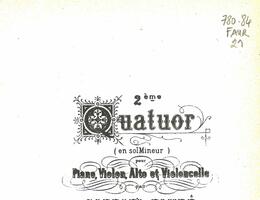Quartet for piano and strings no. 2 in G minor op. 45
Allegro molto moderato – Scherzo : Allegro molto – Adagio non troppo – Finale : Allegro molto
On 22 January 1887, the audience at the Société Nationale de Musique heard the first performance of Fauré’s Piano Quartet No. 2 (dedicated to Hans von Bülow) by the composer (piano), Guillaume Rémy (violin), Louis van Waefelghem (viola) and Jules Delsart (cello). Although the work bears similarities to the First Piano Quartet, with its frequently symphonic textures and whimsical scherzo, there is a marked development in the harmonic language, which shows Fauré at the height of his powers. The style of writing is more restrained and more vehement. In the loquacious Scherzo, for example, the lively pizzicato playing is underlaid by a driving agitation, tinged with anxiety. Opus 45 also occupies a unique place in Faure’s output, because it was not mentioned by the composer before its first performance (it was unusual for him to be so reserved). However, in 1906, he told his wife that the Adagio had been influenced by the sound of bells heard as a boy in Montgauzy. He also commented on this association between memory and the act of composition (the only time he ever put this into words): “Over this drone rises a vague reverie which, like all vague reveries, would be literally untranslatable. But isn’t it often the way that an external event lulls us into thoughts so imprecise that in truth they are not thoughts at all, and yet they are something that gives us pleasure? A desire for things that don’t exist perhaps; and that is indeed the domain of music.” Although Fauré is admitting here that his art is rooted in events that happened during his life, above all he saw it as an expression of the ineffable.

